«previous pageANALYSIS & PLANNING CATEGORY
Honor Award
Celebrating the Cultural Landscape Heritage of Mills College,
Oakland, CA
Robert Sabbatini, ASLA, Karen Fiene and Vonn Marie May, San Francisco, CA
client: Mills College
Project Statement
How do campus planners identify which historic resources are valuable for guiding campus improvements and use the resources in sustainable new designs?
Since 1868, Mills College founders, and those who followed, shaped the campus with Picturesque-era exotic and native plantings and distinguished architecture. In 2006, Mills College sought guidance on how to best preserve, enhance, and further develop this unique campus setting. Funded by the Getty Foundation and Mills College, this landscape heritage study distills the values of the college founders and how these were expressed by nationally recognized landscape architects and architects over 140 years.
The project singles out iconic resources and recommends how to balance future development with historic preservation. The project included historical research, analysis, and planning, and it culminated in design solutions for two key campus precincts to address current and future needs. The study demonstrates that the use of historic resources is integral to sustainable planning and design. The public lecture series, integration of the study into college courses, and publication of a book increased awareness and excitement about this study's findings and recommendations. The result is a campus environment that expresses the unique identity of the institution.
Project Narrative
Sense of place
- This cultural landscape heritage study defines the essence of the campus identity as manifested in its physical and cultural characteristics.
- Research identified distinctive features of the cultural landscape created by distinguished professionals in architecture, landscape architecture, and botany, including Bernard Maybeck, Julia Morgan, Walter Ratcliff, Jr., Howard Gilkey, and Howard McMinn.
- The study guides development within and beyond the historic core of the campus.
Sustainability
- Building on the contributions of past planners and designers is fundamentally sustainable in approach and outcomes. This plan advocates taking cues from and making use of historic campus resources. Often, colleges and universities sweep aside historic resources, wasting the potential physical and cultural contributions they offer.
Resolution of Conflicts
- This study sets out to resolve conflicts between the demands of a 21st-century education and the cultural historic values of the institution.
- As a case in point, the college recently removed more than 100 blue gum (120 years old, 120 feet high). The double row of Eucalyptus was a historic iconic edge to the original campus. Because of the college's depth in horticultural and biological sciences, college faculty advocated the use of native plants to replace the Eucalyptus. This clashed with the cultural history of the college. Recommendations of the landscape heritage plan balanced and resolved the issues and convinced the college to replant the Eucalyptus but with a different species. Just as the founders did more than 100 years ago, the college is currently growing the trees from seed for planting in Fall 2009.
Research, Community Outreach, and Education
- The college conducted a series of four well-attended public lectures. The presenters placed Mills in the national context of the development and evolution of women's college campuses and discussed research on the development of the Mills campus over 140 years.
- The college integrated this study into two undergraduate courses to further appreciation of campus history and its biological setting.
- For the `board of trustees, the study offered insight into the power of the campus to instill a sense of place and fueled enthusiasm to pursue improvements identified in the project's design studies.
- Recognizing the wealth of historic research and its usefulness in informing future campus planning and design, the college published and distributed a well-illustrated book (rather than a planning document) to educate the campus community and to support fund raising for capital projects and landscape improvements.
- The book documents the planning and design steps undertaken, providing a process that can be easily transferred to other institutions.
Implementation
- Mills College is taking its first step in implementing this study, demonstrating that the past can inspire the future. Mills recognized that support for historic resources is often tested when action needs to be taken. Therefore, the college chose a study area that had immediate needs and presented conflicting values. The college used this study to resolve the issues and will replant the double row of Eucalyptus trees in Fall 2009.
- The study demonstrates that high-quality campus design can be achieved through restraint. The simple, yet bold, replacement of the double row of Eucalyptus, the extension of native plantings to create an aesthetic campus context to the buildings, and the use of finer textured materials in areas of high pedestrian use all contribute to success of the guidelines. Exemplary architectural achievements from campus history inspired the study's simple materials palette, ranging from scored, poured-in-place concrete for pedestrian areas to the shuttle stop's metal work, which is inspired by the shape of the blue gum Eucalyptus leaf.
Project Resources
Mills College Participants
Karen Fiene, AIA, Campus Architect
Leah Albin, Mills College Student Assistant
Janice Braun, Special Collections Curator and Director, Center for the Book, F. W. Olin Library
Elizabeth Burwell, former Vice President for Finance and Administration and Treasurer
Dwayne De Fount, former Grounds Manager, Campus Facilities
Louise Gilbert, Director of Development for Foundations and Corporations,Office of Institutional Advancement
Bertram Gordon, Professor of History
Brian Harrington, Architecture Assistant
Renee Jadushlever, Vice President for Operations
Holly Kernan, News Director,
KALW Public Radio and Mills College Visiting Scholar and Lecturer
Karen Maggio, Associate Vice President for Campus Planning
and Facilities
Stephanie L. Mazow, Assistant Director for Foundation and Corporate Relations, Office of Institutional Advancement
Carrie Milligan, Executive Assistant, Office of the Vice President for Finance and Administration and Treasurer
Karma Pippin, Assistant Archivist, F. W. Olin Library
Paul Richards, former Director of Facilities
Virginia V. Rivera, CFRE, CSPG, Vice President for Development
Marianne Sheldon, Associate Provost and Professor of History
Judy Silva, Assistant Vice President for Marketing
Susan Spiller, Assistant Professor of Biology
Andrew Workman, Associate Provost for Academic Affairs
Primary Team Members
Vonn Marie May
Art Zendarski
Role Illustrator (watercolors)
Art Zendarski, Zendarski Studio,
San Francisco, CA
Participating Consultants
Jim Clark, PhDl HortScience, Pleasanton, CA
Peter Ehrlich, Forestry Manager,
San Francisco CA
Ron Lutsko, Jr., Principal, Lutsko Associates Landscape,
San Francisco CA
Betty Marvin, Historic Preservation Planner, City of Oakland, Oakland CA
Lecturers
Phoebe Cutler, Landscape Historian
Helen Lefkowitz Horowitz, Sydenham Clark Parsons Professor of History at Smith College
Vonn Marie May, Cultural Landscape Specialist
Woodruff Minor, Architectural Historian

Funded by the Getty Foundation and Mills College, this landscape heritage plan addresses the entire 135-acre campus while focusing on two areas to test and develop guidelines for the incorporation of historic resources in current planning and design. (Photo: Robert Sabbatini AICP ASLA)
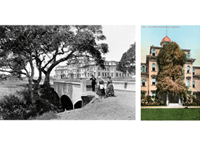
Mills Hall, presumably erected for a women's seminary but with grandeur clearly designed for a college, was also well-regarded for its Rose Porch whose rose vine enveloped the entrance and rose 45 feet. (Photo: Eadweard Muybridge (Helios)/ Unknown (Mills College))
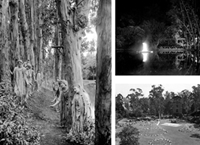
The landscape became integral to the college's culture evidenced by the students costumed as Eucalyptus trees, by the lantern procession and bonfire on Lake Aliso, circa 1916, and by the May Day celebration on The Oval in the late 1940s. (Photo: Unknown (Mills College)/ Milton Mann Studios)
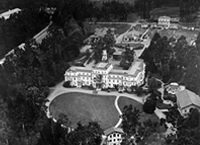
Through the 1920s, The Oval and the buildings around it remained the academic and cultural center of the campus. The founder's plantings - primarily Eucalyptus globulus, blue gum-gave the campus its present park-like character. Native plants matured along creek edges. (Photo: Unknown (Mills College))

Researching campus archives of historic photographs, documents, and of landscape architecture, civil engineering, and architecture drawings revealed a wealth of information. The research allowed the team to illustrate two periods of historic significance in campus development. (Photo: Robert Sabbatini AICP ASLA/ Eadweard Muybridge (Helios))
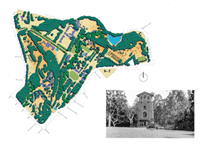
During the second period of significance, the architects, Bernard Maybeck, Julia Morgan, and Walter H. Ratcliff, Jr., the campus landscape architect, Howard Gilkey, and the botanist, Howard McMinn, shaped the character of the campus. (Photo:Robert Sabbatini AICP ASLA / Unknown (Mills College))

Elements of historic interest in place at the end of the campus' second period of historic significance included double rows of London plane trees along Richards Road leading from anew western entrance. (Photo: Robert Sabbatini AICP ASLA)
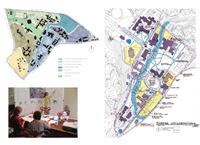
The campus wide landscape assessment revealed seven component landscapes. The college chose two areas of the campus for design studies because of their range of characteristics, challenges, and importance to the college's image. (Photo: Robert Sabbatini AICP ASLA)
"With the help of archival research, the Heritage Plan identifies iconic historic resources that can resolve conflicts between the demands of 21st century educational and the historic cultural values of Mills. Through public lectures and an extensively illustrated book that examines the rich campus history, the landscape architect developed support for the replanting of a double row of eucalyptus trees, but with a different species."
— 2009 Professional Awards Jury
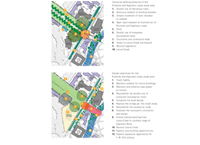
These examples for Richards and Kapiolani Roads illustrate the planning, analysis, and design process. Character-defining features guided the team on how to incorporate the college's unique cultural landscape values into current planning and design. Analysis of the character-defining features, current and future campus functions, and future opportunities yielded twelve design objectives to be incorporated into the design. (Photo: Robert Sabbatini AICP ASLA)
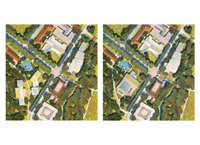
The project explored two program alternatives for two study sites to test and illustrate the flexibility of the guidelines. The resulting design integrates old with new, respecting the historic values of the campus while meeting its needs for education. (Photo: Art Zendarski)
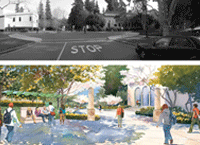
The design opens up views into the heart of the campus and expands the use of native plants. Specific characteristics of the campus landscape, such as the curved shape of Eucalyptus leaves, inspired the design of the shelter and fencing. (Photo: Robert Sabbatini AICP ASLA / Art Zendarski)
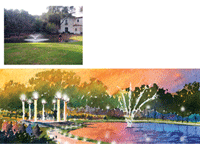
In reference to Howard Gilkey's original design element — the Temple to the Radio — the proposed scheme includes a temple to music adjacent to the pond for gatherings of musicians and artists. (Photo: Robert Sabbatini AICP ASLA / Art Zendarski)
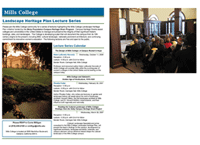
The Landscape Heritage Plan Lecture Series was well attended by alumnae, the college community, and design professionals from throughout the San Francisco Bay Area. (Photo: Carrie Milligan / Robert Sabbatini AICP ASLA)
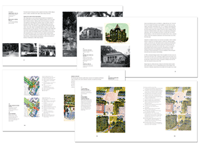
Recognizing the wealth of historical research and its application to campus planning and design, the college published a well-illustrated 160-page book) rather than a planning document) to educate the campus community and to support fund raising for capital projects. (Layout: Robert Sabbatini AICP ASLA)
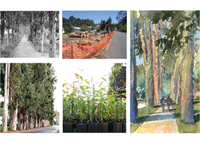
Bryant Path’s blue gum Eucalyptus became a campus icon in the 1880s. In 2007, the college removed the trees. In Fall 2009, based on this study’s recommendations, the college will reestablish the walk with Eucalyptus they are growing from seed. (Photo credit: A) Unknown (Mills College); B) Vonn Marie May; C) Robert Sabbatini AICP ASLA; D) Brian Harrington; E) Art Zendarski)



